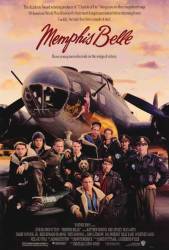Factual error: Phil Lowenstein, the navigator, is hungover when boarding the Memphis Belle. It is obvious to all concerned that he was severely intoxicated the night before the mission. He'd be grounded on the spot and confined to quarters – and this happened a lot in real life.
Factual error: They hold a huge dance in the hangar at night, and Dennis leaves to walk to the Memphis Belle through the hangar doors, which are wide open. The whole flight line, tarmac and hangar are bathed with light - on a US Air Force base in East Anglia during the blackout. Blackout restrictions were rigidly enforced and were not eased until September 1944. The last mission of the Memphis Belle was in May 1943.
Factual error: One of the most carefully rationed materials in World War 2 was rubber. There were no rubber-like plastics or other synthetics in those days, so what were all those balloons at the dance made out of?
Factual error: When the radio operator was asking for a radio check he used a phonetic alphabet. He use the word Tango, representing the letter T. Tango is the modern and current phonetic representation for T. In the 1940's the word was Tare. Able, Baker...Roger, Sugar, Tare, Uncle...Zebra.
Factual error: The Memphis Belle's 25th and final combat mission did not result in her returning to base badly crippled as shown in the film. The propaganda and morale boosting value of her completing her combat life was so important to the U.S. Army Air Force that her final assignment was an uneventful "milk run".
Factual error: These bombers were flying at a very high altitude. The air at that altitude was extremely cold. In fact, many wounded airmen survived because the exposed wounds would freeze and therefore stop the bleeding. Due to the fact that the cabin was not pressurized, this necessitated the need for oxygen,"bomber's jackets" and gloves. Under NO circumstances would airmen remove their gloves to touch metal because their skin would instantly adhere to any exposed metal at that altitude/temperature. This makes the scene with the disappearing/reappearing medal seem unbelievable.
Factual error: Dennis warns the crew not to go without their oxygen masks. Throughout the movie, most of them do. At a service altitude of 25,000 feet any B-17 crew member who went without oxygen for more than one minute would lapse into unconsciousness. After twenty minutes, they would be dead.
Factual error: At the end of the film when the plane is struggling to make it back to the airfield it passes over some corn fields. You can clearly see the tramlines in the field created for the tractors to run through the crop with pesticide sprayers. Such things did not occur at the time of WW II.
Factual error: Bomber crews in WWII were constantly shuffled around to fill losses and train new members or allow repairs on a plane. Contrary to what the film tells us, Captain Robert Morgan's crew only flew 21 missions in Memphis Belle, though bomber and crew both completed 25 total missions.
Factual error: I have read previous remarks on the site referring to the presence of 'tram lines' in the crops in the shots of the crippled bomber struggling to come in to land at the airbase, indicating that this is an anachronism. If you refer to the opening sequence of the film there is a caption referring to the date May 16th. 1943. At that time of year there would have been no golden, ripened wheat/barley in any case. It would still have been green - certainly in those days, when crops would have ripened later, if anything. In most outdoor, daylight shots of the airbase these same ripened crops can be seen in the background, so at least the filmmaker gets this consistently wrong.
Factual error: At the start of the film, the date is shown on-screen as May. During the film, some of the crew are seen talking to the farmer in the adjoining field - the wheat shown is far too advanced for May, and stubble is shown later.
Factual error: For a B-17 crew that has flown 24 missions, those on the Memphis Belle don't act very professional or experienced. Gunners that fall asleep and fight like schoolkids over lucky charms, navigators with hangovers, co-pilots that leave their posts to have a turn at the guns. If the real Belle crew had been like that, they would not have lasted that long.
Factual error: In the movie the Belle wears the wrong nose art. While in service the words 'Memphis Belle' were written in a plain font. The fancy font was added later back in the US for her bonds tour.
Factual error: When Lt. Col Derringer (John Lithgow) is introducing the crew of the Belle at the beginning of the film, he describes Rascal as being 18 years old. Yet he holds the rank of Staff Sergeant (E-6), a rank usually achieved after at least 5-6 years of military service. Same can be said for Eugene, who is described as being 19 years old, who also is a Staff Sergeant.
Factual error: In the last minutes of the film, as Memphis Belle is coming in to land, you just catch a glimpse of a very big hangar. This is Hangar 1 at Duxford, the Imperial War Museum where a lot of the flight filming was based at, and was built in the 1980's. This hangar was rebuilt and enlarged and is now called Airspace.






Suggested correction: British forces adopted the American phonetic alphabet in 1942.
American forces weren't using "Tango" until 1956. When the British and American forces coordinated calling alphabets in 1943, they used "Tare", not "Tango."
Bishop73